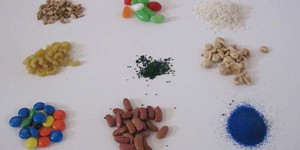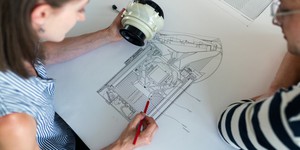Summary
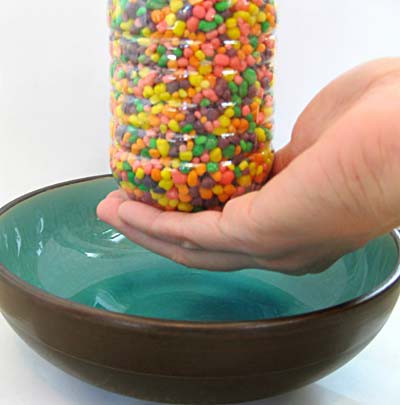
Introduction
Have you ever poured sand out of a bucket, or poured cereal out of a box, and noticed it is a lot like pouring water? It is because sand and cereal are granular materials. This means they are made up of solid particles, but they can actually flow like liquids! Candies, like Skittles®, M&M's®, Nerds® candies and many others, are also granular materials. In this science activity, you will investigate how the size and shape of granular materials affect how they flow. And what better way to do this investigation than with some sweets! So get ready to put your candy to some good scientific use.Materials
- Scissors
- Ruler
- Sheet of paper and pen or pencil
- Calculator
- Stopwatch
- Clear plastic water bottle, 500 mL
- Measuring cup. A graduated one with a spout works best.
- Bowl, medium to large in size
- Different types of candies with different sizes, such as Nerds, Junior Mints, and M&M's (at least 3 types, and at least 1 C of each type). Alternatively, you could use other types of small, solid materials. Tip: For the best results, try to only use candies with similar surface textures and avoid very light-weight candies, such as ones that are hollow or air-puffed.
- Adult helper
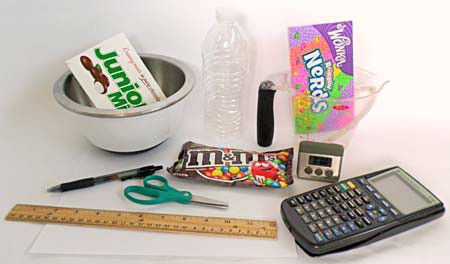 Image Credit: Teisha Rowland, Science Buddies / Science Buddies
Image Credit: Teisha Rowland, Science Buddies / Science Buddies
Instructions
- Have an adult prepare the plastic water bottle so it can be used as a funnel. To do this, carefully cut the bottom off (as close to the end as possible) and carefully cut the top off until the opening size is about 1.3 inches in diameter.
- Measure out at least one cup of the largest type of candy you want to test. The more candy you use, the better your results will be. Exactly how much candy did you measure out? Write this down on a piece of paper.
- Take the bottle you cut and flip it upside down. Have a helper hold the cut bottle, which you will use as a funnel, over a bowl and block the 1.3 inch-wide opening (which should now be at the bottom) with their hand. Pour the measured candy into the top and make sure none leaks out the bottom.
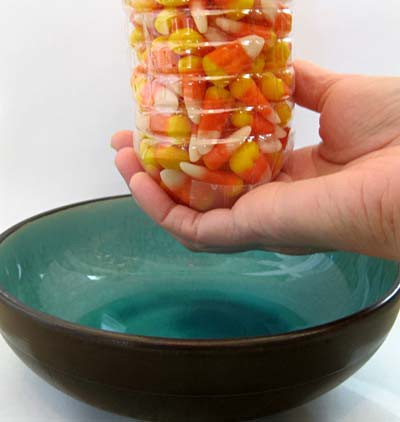 Image Credit: Teisha Rowland, Science Buddies / Science Buddies
Image Credit: Teisha Rowland, Science Buddies / Science Buddies
- Get the stopwatch ready and then have the helper quickly remove their hand and gently shake the funnel. Time how long it takes all of the material to go through the funnel and into the bowl below it.How long did it take for all of the candy to leave the funnel?
- Write the time it took down on your piece of paper.
- Tip: If the material jams the funnel, have an adult make the opening a little larger and try it with the same candy again. Also be sure the helper is gently shaking the funnel the entire time you are timing.
- Calculate the volumetric flow rate of the candy. To do this, divide the volume of the candy by the time it took to flow through the funnel. For example, if you used one cup of M&M's and it took two seconds to flow through the funnel, the volumetric flow rate would be 0.5 cups per second.What is the volumetric flow rate of your candy?
- You may want to try this process a few more times with the same type of candy to see how accurate your results are. Each time you test the candy, be sure to hold the funnel from about the same height above the bowl and shake the funnel in the same way.
- Try this entire process with two other types of candy that are different sizes. What are the volumetric flow rates of the other types of candies?What correlation do you see between the volumetric flow rate and the size of the candies you tested? How do you think other factors, such as surface texture and shape, might affect the volumetric flow rate?
What Happened?
Granular flow rate is complex to accurately calculate because it is affected by a number of factors, including the grains' surface texture, density as a group (and individually), shape and size, as well as the size of the funnel's opening. To try to only investigate the effect of grain size on the flow rate of different types of candies, in this activity you should have only used candies with similar surface textures and avoided very light-weight candies (such as ones that are hollow or air-puffed). Under these conditions, you should have found that the smaller candies, such as Nerds, generally had a greater flow rate than the larger candies, such as Junior Mints. If you also investigated the bulk density of the candies you tested (which is in mass per total volume occupied, including air, such as in grams per cubic centimeter), you may have also seen that there is generally a positive correlation between bulk density and the flow rate. In other words, the greater the bulk density is, the greater the flow rate is.Digging Deeper
Solid matter (like sand) that is made up of many individual small particles is called a granular material, and the individual particles are called grains. Granular materials can range in size from small powders, like sugar and flour, to large objects, like rocks and boulders. Note that the word "grain" does not just refer to things you would traditionally call grains, like sand or rice; it can be any object or particle in a granular material.
For a granular material to behave like a liquid there must be many, many grains close together. For example, a single boulder rolling down a hill is not acting like a liquid; but thousands of rocks, boulders, and dirt particles flowing down a hill during a landslide do behave like a liquid. When granular materials flow like a liquid, it is called granular flow. Understanding granular flow is important for many industries that put things like candy, cereal, or pills into bottles or bags. In these factories, granular materials usually flow out of a large container called a hopper, and through a funnel at the bottom. To put the right amount in each bottle or bag, engineers need to know the granular flow rate of the materials through the funnel.
Ask an Expert
For Further Exploration
- In this activity, you looked at how size affects volumetric flow rate, but other factors affect the flow rate as well. To investigate this, try testing materials that are the same size but have a different surface texture (such as smooth vs. rough or bumpy candies) or are different shapes, such as conical Candy Corns and spherical malt balls. How do other factors affect a material's volumetric flow rate?
- You could do this activity again but instead of measuring volumetric flow rate, you could measure the mass flow rate. What you would need to do is weigh your samples on a scale (or calculate their weight based on the packaging) instead of measuring them in a measuring cup. How does the volumetric flow rate compare to the mass flow rate?
- You could investigate the bulk density of each material. The bulk density of a granular material is in mass per total volume occupied (including air space). Does packing density correlate with the volumetric (or mass) flow rate of the materials?


